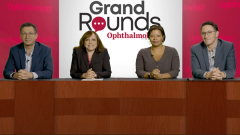
Case 3: Treating nAMD in the Presence of Geographic Atrophy
Retina experts deliberate on the role of fluorescein angiography in AMD and discuss initiation of anticomplement therapy for geographic atrophy in conjunction with anti-VEGF therapy for neovascular AMD.
Arghavan Almony, MD: That was a great case. Let me step back for a second to the diagnosis. We had not 1 but 2 FAs [fluorescein angiograms] in this case. I think a lot of retina specialists are going away from FA more and more for many reasons. Is FA something you regularly use in your retina clinic?
Roger Goldberg, MD: I find FA to be very helpful in patients [with diabetes], particularly ultrawide [field FA], and I think many of the DRCR [diabetic retinopathy clinical research network] protocols, including AC and AA, have shown us that looking at what’s happening in the peripheral retina is quite informative and predictive of what type of risk that patient is at. In wet AMD [age-related macular degeneration], it’s probably a little less helpful to me. Sometimes I like having it, not so much at the dry AMD stage, but I like having it at new onset wet AMD because it sometimes is helpful. [For example], when you have a crazy case like yours, you don’t know up front that that case is going to respond so poorly to aflibercept, so sometimes it is helpful to have a baseline [FA] present at the time of new onset exudation. But I typically do FAs less frequently in wet AMD than in diabetes. What about you guys?
Arghavan Almony, MD: Adrienne, do you agree?
Adrienne Scott, MD: I do agree. I do like a baseline FA prior to treatment and, as Roger mentioned, definitely baseline prior to treatment is helpful because then you can take a step back if they’re not responding. You can go back and see where the patient was at baseline, then compare it [with] how they’re doing after their treatment. Sometimes we need to take a step back and just see where they started and where they are now.
Also, I was struggling a little bit in this case—was there some sort of diagnostic uncertainty? Was it really not neovascular AMD? Choroidal neovascularization? Was I missing another etiology? So, I think it’s really helpful, definitely in cases of diagnostic uncertainty. I agree with Roger completely about baseline ultrawide field [FA] in [patients with diabetes].
Arghavan Almony, MD: Carl, what about you? Do you do a baseline FA on your [patients with] AMD?
Carl Danzig, MD: Sometimes, but mostly not. It depends because, as we all experience in our clinics, we’re all in busy clinics where patients have complicated problems. [With] wet AMD, the diagnosis isn’t always that complicated and doing an FA in the middle of clinic just slows us down more. Now, if we really want to quantify the size of the lesion, [then] perhaps. Sometimes in these patients who are a little [older] than others—this one’s not. Dr Steinle’s family member is 71 years old; that’s quite young. But I have some patients with wet AMD who are in their 90s. They don’t want an FA, but I might do an [optical coherence tomography] angiography for that patient just to look at the size of the neovascular membrane. But for my patients [with diabetes] and [those with] RVO [Retinal vein occlusion], ultrawide field [FA] is commonplace.
Arghavan Almony, MD: Thank you. Adrienne, what would you do for this patient’s geographic atrophy [GA]? Would you do anything? We’re lucky that we now have 2 [Food and Drug Administration]-approved drugs for [GA]. Would you use them?
Adrienne Scott, MD: At this point, I would not. The jury is still out with where I’m going to have those agents fit into my armamentarium. I think they’re great to have as options to offer patients and great in a particularly select group of patients who are motivated for the treatment. The treatment is not without its downsides. One of the challenging parts is we don’t necessarily know all the downsides or which patients are going to be at safety risk or have an adverse outcome. For this patient, it seems like most of the visual morbidity is from the bilateral choroidal vascularization. They seem to be quite stable with their 20/25 vision and are able to be extended quite a bit with their faricimab. But I’m monitoring the GA while we’re treating. It’s something I’m going to have in the back of my mind if I see the GA expand or if the patient seems particularly motivated. But I think we’re OK holding for now.
Arghavan Almony, MD: Thank You. Those were 3 great cases, and we had some good discussion around them. Any final comments before we sign off?
Roger Goldberg, MD: Thank you so much for having us here. This was a phenomenal discussion. Thank you all for joining us.
Adrienne Scott, MD: Thank you, colleagues, for excellent cases. And thank you for excellent moderating.
Carl Danzig, MD: This was a great discussion and a great opportunity to discuss these 3 very interesting cases. Thank you.
Arghavan Almony, MD: Thank you to my copanelists, and thank you for joining us.
Transcript is AI generated and edited for clarity and readability.
Newsletter
Don’t miss out—get Ophthalmology Times updates on the latest clinical advancements and expert interviews, straight to your inbox.














































.png)


